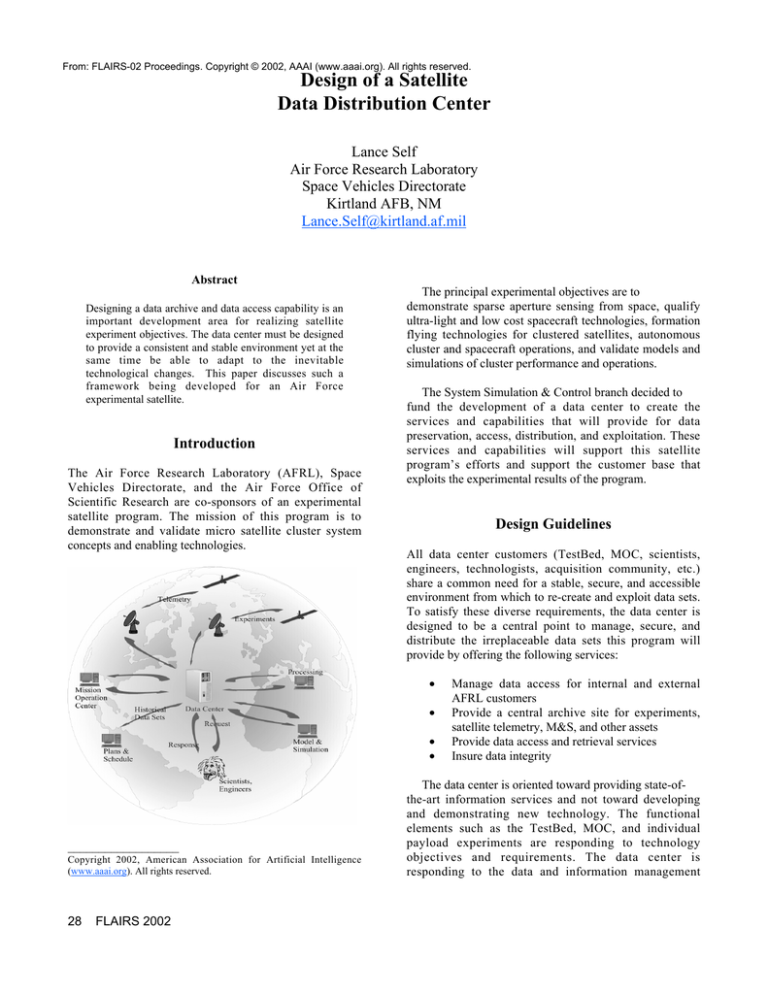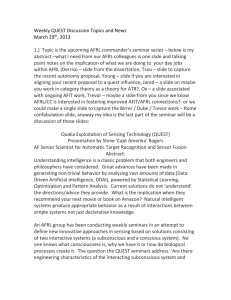
From: FLAIRS-02 Proceedings. Copyright © 2002, AAAI (www.aaai.org). All rights reserved.
Design of a Satellite
Data Distribution Center
Lance Self
Air Force Research Laboratory
Space Vehicles Directorate
Kirtland AFB, NM
Lance.Self@kirtland.af.mil
Abstract
Designing a data archive and data access capability is an
important development area for realizing satellite
experiment objectives. The data center must be designed
to provide a consistent and stable environment yet at the
same time be able to adapt to the inevitable
technological changes. This paper discusses such a
framework being developed for an Air Force
experimental satellite.
Introduction
The Air Force Research Laboratory (AFRL), Space
Vehicles Directorate, and the Air Force Office of
Scientific Research are co-sponsors of an experimental
satellite program. The mission of this program is to
demonstrate and validate micro satellite cluster system
concepts and enabling technologies.
The principal experimental objectives are to
demonstrate sparse aperture sensing from space, qualify
ultra-light and low cost spacecraft technologies, formation
flying technologies for clustered satellites, autonomous
cluster and spacecraft operations, and validate models and
simulations of cluster performance and operations.
The System Simulation & Control branch decided to
fund the development of a data center to create the
services and capabilities that will provide for data
preservation, access, distribution, and exploitation. These
services and capabilities will support this satellite
program’s efforts and support the customer base that
exploits the experimental results of the program.
Design Guidelines
All data center customers (TestBed, MOC, scientists,
engineers, technologists, acquisition community, etc.)
share a common need for a stable, secure, and accessible
environment from which to re-create and exploit data sets.
To satisfy these diverse requirements, the data center is
designed to be a central point to manage, secure, and
distribute the irreplaceable data sets this program will
provide by offering the following services:
∑
∑
∑
∑
__________________
Copyright 2002, American Association for Artificial Intelligence
(www.aaai.org). All rights reserved.
28
FLAIRS 2002
Manage data access for internal and external
AFRL customers
Provide a central archive site for experiments,
satellite telemetry, M&S, and other assets
Provide data access and retrieval services
Insure data integrity
The data center is oriented toward providing state-ofthe-art information services and not toward developing
and demonstrating new technology. The functional
elements such as the TestBed, MOC, and individual
payload experiments are responding to technology
objectives and requirements. The data center is
responding to the data and information management
needs of these elements in addition to those of the satellite
program office and external users interested in the
technology that is captured in the data and information
maintained by the data center.
Data Center Design
This section discusses the overall design of the Ground
Element and specifically how the data center fits within
that element. It discusses the design approach the data
center is taking, the flow of information between ground
element components, where and how the data center
ingests data, and finally a deployment model.
The data center has three principal sources of data:
TestBed, Mission Operations Center, and on-board
satellite experiments. The broader range of data center
customers, researchers, scientists, etc., will use data sets
collected from those groups to perform further processing,
analysis, and experiments. At times, however, these
external customers may choose to store data to the data
center on an ad-hoc basis.
For purpose of reference, the applications, processes,
and the database management system (DBMS) lie within
Layer 7 (Application layer) of the OSI model. Within that
OSI layer the data center has adopted the model depicted
below (Figure 1) to define the internals of where various
processes lie and what messages are passed between these
layers. This model equally applies toward an E-business
as well as what the data center is developing, and is
consistent with a modular object-oriented approach.
format data is presented to the user. What the user “sees,”
buttons the user clicks, etc., is invoked at this layer.
Everything above this layer should be transparent to the
user, that is to say, how a business rule is implemented or
what internal process the database engine uses, takes
place behind the scenes. Above that is the Business Rule
layer that receives raw data and maps an action or event
to a pre-defined rule. If a user clicked on the
add_customer button for example that event is mapped to
some function that is brought into play because of that
action. Next up in the hierarchy is the Application
Interface layer that converts the function, add_customer
for example, into a language the Application Server layer
can implement. The result (Result Set) of that
implementation, i.e., the results of a query, are passed
back down the layers and presented to the user in the
correct format.
This model hides layers, such as a proxy layer, that
more definitively describes the process of taking a request
from a user and presenting the results of that request.
However, for data center development, this model serves
the intended purpose since those layers that are absent
from this model are, for the most part, embedded in the
tools that the data center will use to build the applications,
methods, and processes for customer use.
Ground Element
Figure 2 shows how information is channeled between
external customers and the ground element, and between
ground element components and the data center. External
customers that want access to AFRL assets will cross
through the AFRL firewall to access servers that are
located between the Kirtland and AFRL firewalls. First,
before crossing AFRL firewall boundaries, users must
have submitted the proper documentation and been
assigned a login name and password by AFRL. Once
inside the AFRL firewall users can access the two servers
that have tools with which to conduct their business. The
tools server, Anasazi, houses development tools such as
RealTime Studio Pro and Perforce. The other server,
Marmot, houses the Data Services Interface that allows
users access to the data center server, Hoahu.
Figure 1: Data Center Design Model
At the bottom of the model is the Data Capture or
“user’s view” layer. This layer defines how and in what
FLAIRS 2002
29
from the data center to external customers, using the
AFRL Internet network.
The Data Services Interface is connected to the AFRL
LAN. All data exchanged between the data center and
customers use the Data Services Interface regardless of
their physical location. If a ground element component
needs to store satellite telemetry files to the data center, or
if a customer in Boston wishes to retrieve experiment
data, they would both use the Data Services Interface to
conduct their business with the data center. One subtlety
to note is if a MOC console (Mission Planning, Flight
Dynamics, etc.) or TestBed console wishes to use the
Data Services the DASL Network switch must be in the
correct position.
Figure 2: Information Channels
Beneath the Kirtland firewall are the Mission
Operation Center and the TestBed, which are connected
to the DASL LAN (Figure 3). This is an internal Ethernet
sub-network, running at 100 Mbps, that creates an
uninterrupted means for the TestBed and MOC to
exchange data without disruptions (such as email) from
the AFRL network. The DASL LAN links physical
components located within the DASL room, where most
of the equipment is located, and can be switched to the
external AFRL network using the DASL network switch.
Deployment
The Deployment diagram (Figure 4) shows how the
hardware and software that make up the system are
configured and distributed from a data center perspective.
The large blocks are nodes that are used to depict a
physical element, and within the nodes are components.
Figure 4: Deployment
Figure 3: Ground Element Architecture
The data center hardware and software architecture is
built around a client\server framework based on COTS
and GOTS components. The data center primarily resides
on the AFRL Intranet \ Internet network but can be
switched, using the DASL network switch, to the DASL
LAN. This configuration allows for the exchange of data
from ground element components to the data center, and
30
FLAIRS 2002
Each of the gray nodes (MOC, TestBed, External
Customers, Ground Station) is a major source and/or sink
of data sets that physically exist. Each, with the exception
of the Ground Station, has a direct Internet link to the DSI
via the web server. The AFRL/VSI node houses the Drop
Box component that is also linked to the DSI. Using the
Web Server these various nodes and components gain
access to the data center and the components housed
within.
Enabling Technologies
Microsoft .NET (dot net) is Microsoft’s latest push at a
platform for XML web services that is their vision of
connecting people and information. This platform enables
the use of XML based applications and processes to work
together to perform a task or service to the consumer
while using the HTTP protocol as the vehicle to transport
these applications and processes. Conceivably, these
applications will run on any smart device such as phones,
handheld computers, and laptops, and is the next
generation of Internet based computing.
The .NET is being designed to let programmers write
XML web services instead of focusing on writing standalone applications. These web services will be interacting
with other web services to form a loosely coupled
“constellation” of software programs dependent on XML
as the communication venue. To achieve this Microsoft
has developed tools that permit the programmer to
develop these “constellations”, primarily Visual
Studio.NET.
.NET is comprised of a library of objects that the
developer uses to create applications in a similar manner
that the old Windows API did such as creating windows,
dialog boxes (specialized window), threads, etc. The
.NET also adds features of connecting to databases or the
Internet using the objects contained in the library. The
second area .NET provides is the environment to run
these applications via the .NET Runtime (a.k.a. Common
Language Runtime or CLR).
are the languages supported (C#, Visual Basic.NET,
Java), deployment of applications over the Internet, and
the database modeling support.
Using any language to write deployable applications
permits developers to use that which they are most
familiar. Visual Basic programmers can write applications
in that language while C# programmers can use their
experience in C#. The need to learn a new language is
eliminated which increases programmer productivity. The
data center has a mix of developers with such varied
programming backgrounds, and this is expected to be the
future case.
Writing deployable applications will benefit this
satellite program in that data center staff as well as any
others can write programs. Deploying applications to
customers over the web will let them use the experience
of those developers that are closest to the problem
domain. This should decrease the time for Verification &
Validation tests and allow sharing of data (including test
results) over the Internet. .NET is using XML so these
applications will be able to be used on any system (UNIX,
PC) over any browser.
Conclusion
A secure, stable operating environment is an important
link when dealing with experimental satellites.
Researchers, scientists, and engineers need assurance that
data integrity is maintained throughout the satellite lifecycle. However, the environment should also be able to
adapt to technological advances, which was a driving
force behind this development effort.
Figure 5: .NET Environment
Visual Studio.NET is Microsoft’s latest IDE that
focuses on creating XML based web services. Included
are a number of tools for developers and modeling tools
that support UML. Of particular interest to the data center
FLAIRS 2002
31


